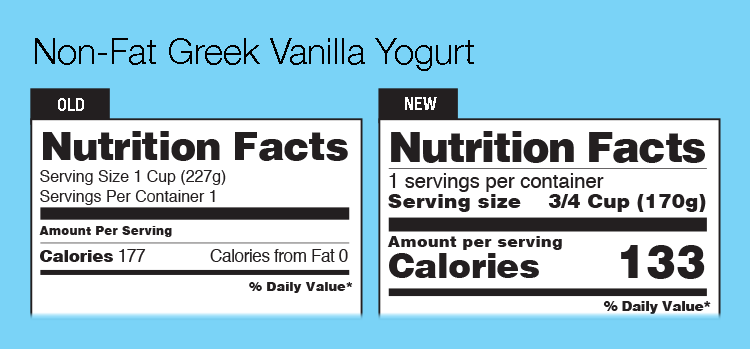How the New Nutrition Facts Label Could Help You Lose Weight

One of the biggest changes you’ll see on the new Nutrition Facts label when it rolls out a little over two years from now is the bigger, bolder number used to display the amount of calories a food contains.
This is a good thing. Obesity rates are on the rise, and overconsumption of calories is a major cause of obesity. It’s more important than ever to know how many calories there are in the foods you eat, and how to use the information on the Nutrition Facts label to help you lose or maintain your weight.
We mocked up some examples of the Nutrition Facts label both current and new to show you how the change in design may take some of the guesswork out of healthful eating.

The calorie count on the new label is much larger, so you can’t miss it. You also may be surprised to see how many calories there are per serving of a food, even ones you might think of as healthful. It's better to dunk your veggies in hummus, which is typically made with chickpeas and tahini (ground sesame seeds), than in onion dip, which often contains sour cream, mayonnaise, and olive oil. But it’s pretty easy to eat more than 2 tablespoons of hummus when you’re using it as a dip for carrots, for instance. A more realistic half-cup serving will cost you 200 calories.

The amount of a food that constitutes a serving will be bolded and more prominently placed. For many foods, this information will also be updated with more realistic serving sizes to reflect amounts that consumers are actually eating. For example, you’ll see that the new serving size for yogurt will be lowered from 1 cup to ¾ of a cup.

Another big change: you won't see a line for calories from fat anymore because the type of fat you eat is more important than the amount, the Food and Drug Administration says. Peanut butter supplies heart healthy monounsaturated fat, which can help lower your risk of heart disease and stroke. This type of fat is much better for you than saturated and trans fats, which over time can increase your level of LDL "bad" cholesterol.
More from Consumer Reports:
Top pick tires for 2016
Best used cars for $25,000 and less
7 best mattresses for couples
Consumer Reports has no relationship with any advertisers on this website. Copyright © 2006-2016 Consumers Union of U.S.

 Yahoo Finance
Yahoo Finance 